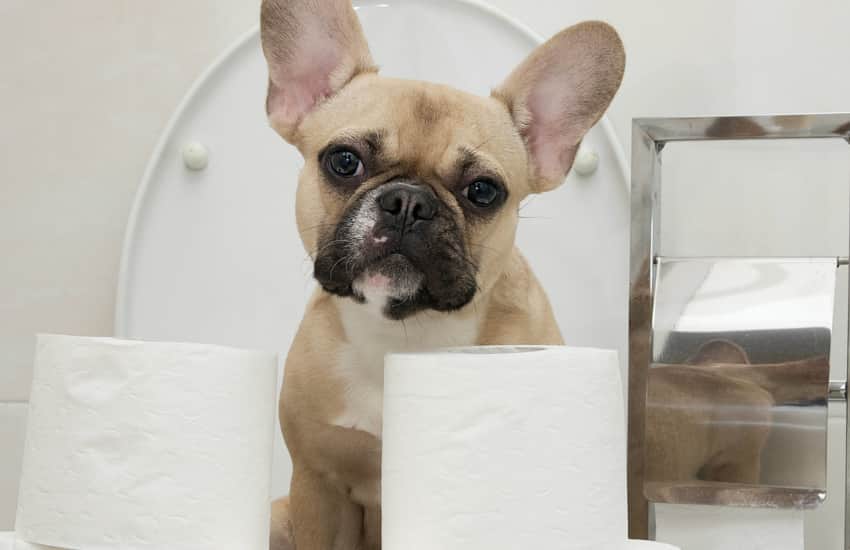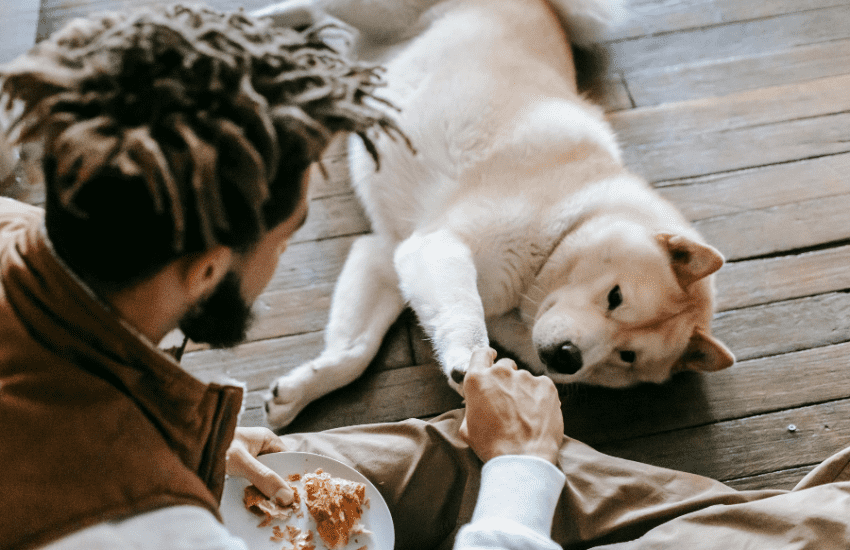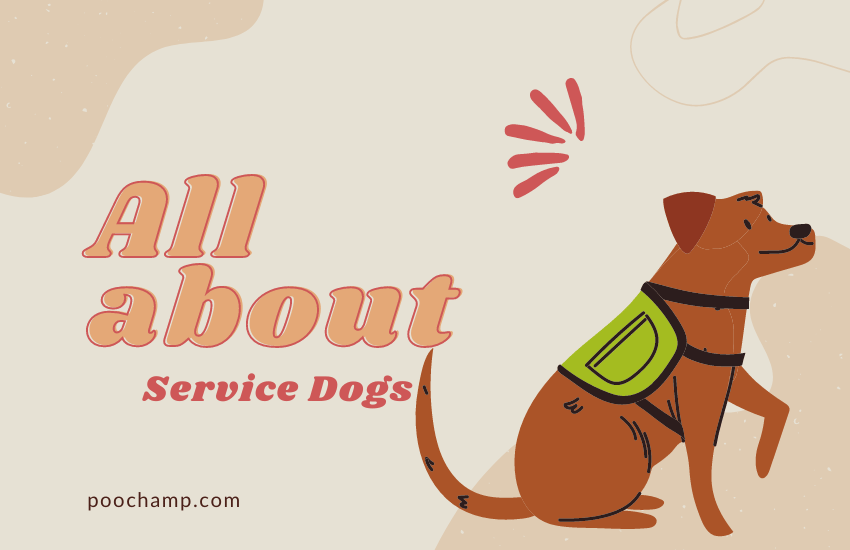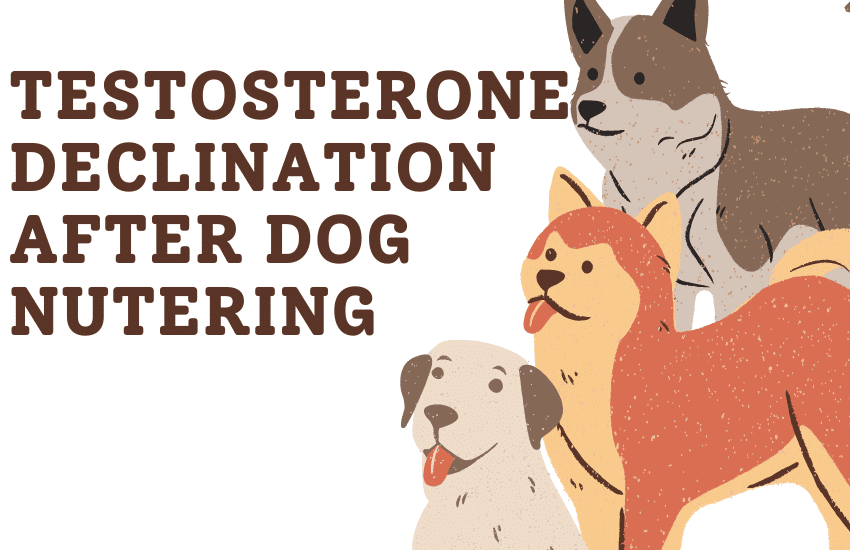Are you tired of dealing with your furry friend’s messy and unpleasant bouts of Diarrhea? Have you asked yourself how to stop Dog diarrhea fast? If so, you’re not alone. Dog diarrhea can be a common and frustrating issue for pet owners. Still, the good news is that plenty of effective home remedies help alleviate this discomfort for your beloved pup.
From dietary changes to natural supplements and simple lifestyle adjustments, there are numerous ways to tackle dog diarrhea without always having to rush to the vet. In this article, we’ll explore some practical tips and techniques that will empower you to confidently manage your dog’s digestive health from the comfort of your home.
Understanding dog Diarrhea.
When a dog experiences Diarrhea, the delicate balance of bacteria in its digestive system becomes disrupted. This imbalance can lead to increased fecal water content and more frequent bowel movements. In addition, inflammation of the intestines can occur, leading to discomfort for the dog.
As Diarrhea progresses, the body works overtime to rid itself of harmful pathogens or toxins that may be causing the upset stomach. The intestinal lining may become irritated and inflamed, causing further distress to the dog’s body. These physiological responses indicate a more significant digestive system issue requiring attention and care.
Furthermore, nutrient absorption is compromised during Diarrhea, potentially leading to malnutrition if left untreated. This highlights how vital it is to promptly address this common health problem in dogs, as prolonged symptoms can have severe implications for their overall well-being.
In our previous article, we dug into the causes and methods of preventing dog diarrhea in detail. But to circle back, here’s a quick recap of some common reasons dogs may experience Diarrhea.
Why does my dog have diarrhea?
- Diet: A sudden change in diet can lead to Diarrhea in dogs. Like humans, dogs need time to adjust to new food, so switching from one brand or type of food to another can upset their digestive system. Dietary indiscretions, such as consuming garbage or toxic substances, can also result in temporary episodes of Diarrhea in dogs.
- Parasites: Intestinal parasites such as worms or giardia can cause Diarrhea in dogs. These parasites disrupt the normal functioning of the intestines, leading to loose stools and discomfort for our furry friends.
- Stress: Just like humans, dogs can experience stress and anxiety. Whether it’s due to changes in their environment, separation from their owner, or other factors, stress can cause digestive issues and result in Diarrhea for our canine companions.
- Viruses and bacteria: such as parvovirus and salmonella can invade a dog’s gastrointestinal tract, leading to inflammation and Diarrhea. These microorganisms are often transmitted through contaminated food or water, causing distressing symptoms in our furry friends.
- underlying health conditions: can also trigger Diarrhea in dogs. Inflammatory bowel disease, pancreatitis, and allergies are just a few health issues that can disrupt the digestive system and lead to loose stools.
- side effects of medications: Just like humans, dogs can experience stomach upset or Diarrhea due to taking certain medications. Antibiotics, in particular, disrupt the balance of good bacteria in the gut, leading to digestive issues in dogs.
- vigorous exercise: While regular physical activity benefits a dog’s health, excessive or strenuous training can sometimes lead to gastrointestinal upset. When dogs engage in overly energetic play or exercise without proper hydration and rest, it can stress their intestines and result in loose stool or Diarrhea.
The color of a dog’s poop can provide valuable insights into their health and diet. Here’s an infographic with a brief guide to what different colors might indicate:
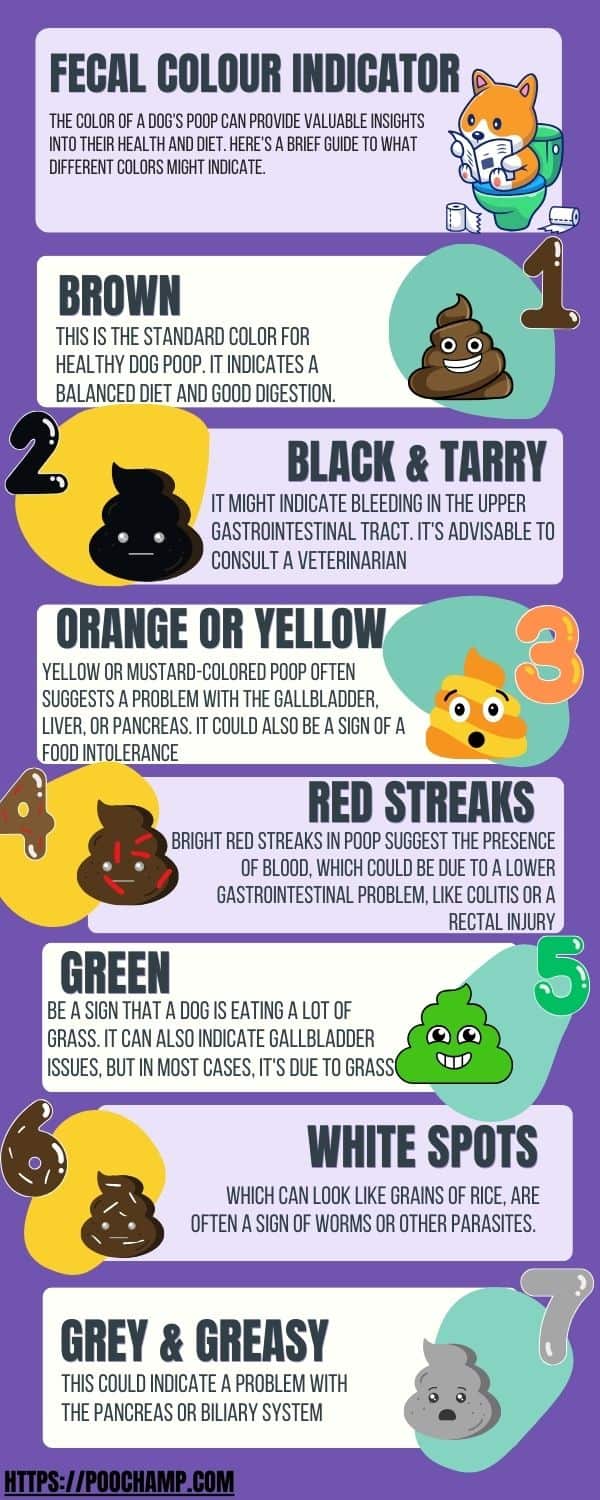
Here is another infographic showing what the ideal dog’s fecal should look like:

When to call a veteranarian
1-Dramatic changes like bloody stools or black and tarry stools.
2-noticeable lethargy or weakness.
3-continuously vomits (especially after consuming food or water).
4-prolonged and persistent Diarrhea that lasts more than 48 hours is a sign of severe health concern.
5-loss in appetite or weight loss.
6-persistent straining with little fecal output, pale gums, and visible discomfort in the stomach area.
7-if you notice worms in your dog’s stool or vomit.
8-If you believe your dog has swallowed poison or a foreign object like a toy.
9-Existing health conditions.
10-If your dog is on medication like antibiotic.
11-If your dog is old.
If you notice any of the above signs, it’s crucial to call the veterinarian immediately.
what to feed dog with Diarrhea-
Home Remedies
1-fasting and hydration
Step one in how to stop dog diarrhea is soothing your dog’s stomach. It should be to withhold food for 12 to 24 hours. This allows the bowel wall to relax from overly excited contractions and allows the digestive tract some ‘quiet time’ to heal, recuperate from any irritation causing Diarrhea, and reestablish healthy bacteria, which are often overpowered by harmful bacteria during diarrhea episodes.
Moreover, it flushes out any toxic substances that may be triggering their upset stomach. Remember that this is not starving your dog but temporarily withholding food under controlled circumstances to aid healing.
At this point, provide your dog with access to fresh water. As many dogs may become reluctant to drink when feeling queasy,
Hydration, often overlooked but vitally important, plays a pivotal role in your dog’s recovery during fasting.
When battling Diarrhea, your pet’s body loses fluids at a rapid rate, causing dehydration, which can lead to severe complications if not addressed urgently. Make sure that they drink slowly – large volumes at one time could upset their stomach and result in Diarrhea returning.
Maintaining optimal hydration levels throughout your dog’s fasting period makes the healing process remarkably efficient. The body relies on water to flush out toxins and harmful bacteria while facilitating digestion and nutrient absorption—almost refurbishing the whole system! Remember that hydration doesn’t just mean upping the water intake; supplying electrolytes is equally crucial, with options such as bone broth or solutions designed for children and babies being good choices. Also, rice water is used to add the body essential nutrition. You can also use unflavored Pedialyte, but first test if your dog will tolerate it.
Bone broth.
Bone broth is an excellent natural electrolyte. It’s full of essential vitamins and minerals that boost your dog’s overall health while ensuring they stay adequately hydrated—think of it as an all-in-one multivitamin/hydration combo. Packed with bone-building calcium and phosphorous alongside immune system stimulators like vitamins C and D, these broths are easy on the stomach but nourishing at the same time.
Not just vital for hydration, consider clear broths too; chicken or beef-flavored ones offer much-needed protein without excessive fat content, which could exacerbate your dog’s condition.
Bone broth recipe.
- 2 pounds of beef or chicken bones
- 4 cups of water
- 1 tablespoon apple cider vinegar
Instructions:
- Place the bones in a large pot.
- Add the water and apple cider vinegar to the pot.
- Cover the pot and bring it to a boil over medium heat.
- Once boiling, reduce the heat to low and let it simmer for about 24 hours.
- After simmering, let it cool down before straining out the bones.
- Store the broth in an airtight container in your refrigerator and serve small amounts to your dog as needed.
Rice water.
Rice water helps soothe your dog’s disturbed tummy and is a nutritious energy source in their time of need. Amino acids and vitamin B in fortified rice water are essential for proper cell functioning and metabolism while aiding the repair process.
Rice water recipe
- 1 cup of rice
- 4 cups of water
Instructions:
- Take a pot and pour 4 cups of water into it.
- Add 1 cup of rice to the water.
- Heat the mixture over medium heat until it starts boiling.
- Lower the heat, cover the pot, and let it simmer for about an hour.
- After an hour, strain the liquid from the rice using a fine-mesh sieve.
- Allow the liquid to cool completely before serving it to your dog. Start with small amounts to see if your dog tolerates it well.
- The rest can be stored in a refrigerator for up to three days.
Caution.
Puppies in the growth phase need an unbroken supply of nutrients to fuel their development; hence, withholding food can impact them detrimentally.
Similarly, elderly dogs often grapple with existing health conditions or have weaker digestion; fasting might put further stress on their system rather than relieving it. So before you try this method with your four-legged buddy’s diarrhea, remember – not all remedies are one-size-fits-all!
2-Bland diet
After fasting, you must start feeding your dog with easy-to-digest food.
You may have wondered what to feed dog with diarrhea before, feeding him bland food could significantly help in managing the condition. As such, a diet doesn’t simply aim to bore your pet but is more about speeding up recovery. The low-fat, easily digestible constituents and fiber-rich elements of bland food help stool solidify, reduce bowel propulsion, and normalize gastrointestinal activity.
Feeding bland food also limits further irritation of the dog’s digestive tract, enabling it to repair itself effectively while reestablishing balanced gut flora. So remembering “bland equals better” becomes crucial during these exhausting times.
- Boiled white skinless chicken meat and plain cocked white rice, empty of any spices or oils. This comforting blend offers uncomplicated sustenance that’s easy on their tummy.
- Plain yogurt can be beneficial for dogs who can tolerate milk and milk products, as it can aid in restoring the balance of healthy bacteria in the gut.
- Plain, low-sodium, low-fat cottage cheese can offer protein and calcium without upsetting the digestive system.
Ask your veterinarian before offering any milk products to your dog, as the lactose in these products can worsen your dog’s case.
- Boiled potatoes without skin are easily digestible and can provide a source of carbohydrates for energy.
- Plain protein sources such as cooked eggs (without butter or oil) can provide essential nutrients while being gentle on the stomach.
How long to keep my dog with Diarrhea on a bland diet?
Typically, vets recommend keeping your canine companion on a bland diet for at least 2-3 days post the final instance of Diarrhea. However, it may take up to 5-7 days in some cases, depending upon the severity and cause of the upset tummy. Once you consistently observe solid stools, give your dog another 3 to 5 days on the bland diet. After that, you can reintroduce regular food gradually over several meals split across one to two weeks to ensure full recovery of inflammations.
Please don’t make the transition quickly so as not to shock their digestive system and potentially trigger another episode of Diarrhea.
Remember
Every dog is unique, and these guidelines may vary somewhat; always consult your vet if any concerns arise during recovery.
Can I give Pumpkin to my dog with diarrhea?
Canned pumpkin (not pie filling, as it contains sugar and other substances) could be an equally effective remedy for a dog’s loose stool. The high fiber content in pumpkin helps in aiding digestion by absorbing excess water in the digestive tract and adding bulk, making stools firmer, thus facilitating regular bowel movements, while its rich supply of essential nutrients such as A & C, which supports the overall health of your dog while dealing with their upset tummy.
It also offers another layer of defense by helping lower pH levels in the gut, which creates an environment unfavorable for harmful bacteria. Pumpkin can also act as a prebiotic, enhancing beneficial gut bacteria and aiding gastrointestinal ecosystem balance.
Make sure that the pumpkin is labeled with 100% Pumpkin.
Canned pure pumpkin is highly recommended.
The reason? This form retains all the nutritional advantages and ensures ease of digestion since it’s cooked. Moreover, avoid any forms with added spices or sugars, as they could worsen your furbaby’s conditions.
Ensure you provide your dog with enough fresh water when using high-fiber food like pumpkins.
How much pumpkin to give a dog with Diarrhea.
One or two teaspoons should suffice for smaller dogs, while larger breeds may need up to two tablespoons. Even though it’s a natural food product, adding too much suddenly could unintentionally worsen the problem rather than solve it. Remember: Be cautious and consult your vet when introducing new foods into your dog’s diet!
Psyllium fiber.
Psyllium fiber has been a secret weapon for many pet parents when battling the unpleasurable experience of a dog with Diarrhea. It’s not just about cleaning up the mess and hoping for it to subside, but to quickly get your furry friend feeling better. Giving your dog some psyllium fiber is an excellent resolution as it helps form bulkier stools by absorbing water in the intestine.
Psyllium can be purchased as a whole husk. Make sure it is unsweetened and unflavored. Also, read the label. It is crucial not to contain xylitol as it is toxic for pets.
The use of Psyllium is straightforward: mix it with their food or drink. Start with small doses, such as a teaspoon for smaller dogs or a tablespoon for larger breeds; adjust accordingly based on how well they respond. However, always consult your vet before initiating this remedy, as sudden changes in diet can sometimes complicate matters.
Remember
Hydration is critical! Psyllium absorbs water; therefore, ensuring your puppy drinks plenty can maximize its benefits without leading to possible constipation from dehydration.
Slippery Elm.
Slippery Elm (Ulmas rubra), another safe and effective herbal supplement to aid intestinal healing, has proven highly effective in soothing a dog’s digestion and curing Diarrhea. The high fiber content aids in hardening the stool, while the mucilage supports soothing the digestive tract.
Creating a Slippery Elm broth is easy. Mix 1/4 teaspoon of Slippery elm powder for every 10 pounds of your dog’s weight into a thick mixture with cold water before slowly adding hot water while stirring continuously. Not only does this blend ease digestive upset, but dogs also find its sweet taste irresistible.
Fennel.
Fennel, a versatile herb known for its culinary and medicinal properties, can offer much-needed relief to dogs suffering from Diarrhea. Rich in fiber and natural oils, fennel helps to soothe the gastrointestinal tract and reduce inflammation. Its anti-spasmodic properties can also calm intestinal muscles, minimizing discomfort and promoting smoother digestion.
In addition, fennel’s high concentration of volatile oils like anethole can effectively combat the bacteria responsible for triggering Diarrhea in dogs. These antibacterial properties can support overall gut health. Incorporating fennel into a dog’s diet is a gentle yet powerful way to alleviate digestive distress.
The recommended amount of fennel to administer will vary based on the dog’s size. For small dogs, around 1/4 teaspoon of finely ground fennel seeds mixed into their food should suffice. In comparison, larger dogs might benefit from up to 1 teaspoon.
When using fennel to soothe a dog’s gut, it’s essential to consult with a veterinarian for guidance on the proper dosage and frequency. It’s also crucial to source high-quality fennel and ensure it is free from additives or potential contaminants. Additionally, monitoring the dog’s response to the fennel and adjusting the dosage as necessary is essential to using this natural remedy effectively.
Chicken & pumpkin with fennel Recipe
- 2 pounds chicken thighs
- 1 cup water
- 2 cups finely chopped green beans
- ½ teaspoon whole fennel seed
- 28 ounces of plain pumpkin puree
Instructions:
1- shred the chicken into small pieces, depending on the size of your dog.
2- Combine the chicken and water in a pan and
Allow boiling over high heat.
3- Reduce the heat to medium and simmer for 15 minutes.
4- Add the green beans to the pan and simmer for five more minutes.
5- Grind the fennel until it becomes a fine powder.
6- Remove from the heat and stir in the ground fennel.
7- Allow to cool for 5 minutes, then add in the pumpkin and mix it.
Daily portion 11/2 to 2 cups per 10 pounds of your dog’s weight.
3-How to stop dog Diarrhea using Probiotics.
When it comes to finding the best probiotics for dogs with Diarrhea, it’s essential to look for products that contain live and active bacteria known to support digestive health. One top contender is Lactobacillus acidophilus, a well-researched strain shown to help improve gut function and reduce Diarrhea in dogs.
Bifidobacterium animalis is another probiotic strain commonly found in supplements designed for canine digestive health. This particular strain has been linked to promoting healthy digestion and balancing gut bacteria in dogs.
Another probiotic strain worth considering is Enterococcus faecium, which has been demonstrated to aid in preventing and treating Diarrhea in canines.
These probiotics work by replenishing the beneficial bacteria in your dog’s gut, helping to restore balance and support overall digestive function. When selecting a probiotic supplement for your dog, choose one specifically formulated for pets, as human probiotics may not have the same impact or be safe for canine consumption. Always consult your veterinarian before introducing new supplements into your dog’s diet.
Reference:
Herstad HK, Nesheim BB, L’Abée-Lund T, Larsen S, Skancke E. Effects of a probiotic intervention in acute canine gastroenteritis–a controlled clinical trial. J Small Anim Pract. 2010 Jan;51(1):34-8. doi: 10.1111/j.1748-5827.2009.00853.x. PMID: 20137007.
4-Rebound Recuperation Formula:
The Rebound Recuperation Formula has emerged as a reliable solution when dealing with dog diarrhea. This formula contains a carefully balanced combination of electrolytes, probiotics, and prebiotics that work together to restore balance in the digestive system. The electrolytes help replenish those lost during bouts of Diarrhea, while probiotics and prebiotics promote the growth of healthy gut bacteria.
By supporting the growth of beneficial bacteria, this formula aids in improving digestion and nutrient absorption for long-term recovery. Additionally, its easy-to-administer liquid form ensures quick absorption and effectiveness. Overall, the Rebound Recuperation Formula offers a complete approach to targeting immediate relief and long-term digestive wellness.
Why you shouldn’t use IMODIUM without a prescription from your veterinarian
Imodium, also known as loperamide, is a medication often used to treat Diarrhea in humans. However, it can also be used to manage Diarrhea in dogs under the guidance of a veterinarian. Imodium works by slowing down the intestines’ movement, which helps decrease the frequency and urgency of bowel movements.
It’s important to note that Imodium should only be given to dogs under the direct supervision of a vet, as improper dosing can lead to potential side effects such as lethargy, vomiting, or constipation. Additionally, Imodium is unsuitable for all types of dog diarrhea and may not address underlying causes such as infections or dietary issues.
Overall, while Imodium can help manage acute cases of Diarrhea in dogs when used correctly and at the proper dosage, pet owners must consult with their vet before administering any medication to their furry friends. Understanding the potential risks and benefits will ensure your pet receives appropriate care tailored to their needs.
What Will Your Veterinarian Do If your dog suffers from persistent Diarrhea?
When your dog experiences persistent Diarrhea, a thorough evaluation by a veterinarian is essential to determine the underlying cause. Various tests may be recommended based on the clinical presentation of your dog.
Fecal testing is typically performed to check for parasites, bacteria, and other pathogens that could be causing the Diarrhea.
Additionally, blood tests may be conducted to assess for signs of infection or inflammation and to evaluate organ function and overall health.
In some cases, further diagnostic imaging such as X-rays or ultrasound may be necessary to rule out structural issues or foreign body ingestion that could be contributing to your dog’s symptoms.
These tests can provide valuable insights into the root cause of the Diarrhea and help guide appropriate treatment strategies. Overall, the combination of fecal testing, blood work, and diagnostic imaging provides a comprehensive approach to identifying the source of your dog’s gastrointestinal distress and ensuring effective management.
FAQ
1- What are the common causes of Diarrhea in dogs?
Common causes of Diarrhea in dogs include dietary indiscretion, parasites, bacterial or viral infections, food intolerances, and stress.
2- How can I treat my dog's Diarrhea at home?
You can treat your dog’s Diarrhea at home by fasting for 12-24 hours, providing a bland diet such as boiled chicken and rice, and ensuring access to plenty of fresh water.
3- When should I be concerned about my dog's Diarrhea?
You should be concerned if your dog’s Diarrhea persists for more than 24 hours, is accompanied by blood or mucus, or if your dog shows signs of lethargy or dehydration.
4- Can I give over-the-counter medications to my dog for Diarrhea?
Giving over-the-counter medications to your dog without consulting a veterinarian first is not recommended, as some medicines may worsen the condition.
5- Should I still walk my dog when they have Diarrhea?
It is best to limit exercise and walks while your dog has Diarrhea to allow them to rest and recover.
6- Are there any specific foods that can help my dog's Diarrhea?
Foods like plain white rice and boiled chicken can help soothe your dog’s upset stomach and firm up their stools.
7- How can I prevent my dog from getting Diarrhea in the future?
Preventative measures include:
- Feeding a balanced diet.
- Avoiding sudden changes in diet.
- Keeping vaccinations up-to-date.
- Practicing good hygiene.
- Controlling access to garbage or other potential sources of harmful substances.
8- How long does acute Diarrhea in dogs typically last?
Acute Diarrhea in dogs typically lasts for 1-2 days but can persist longer depending on the underlying cause.


